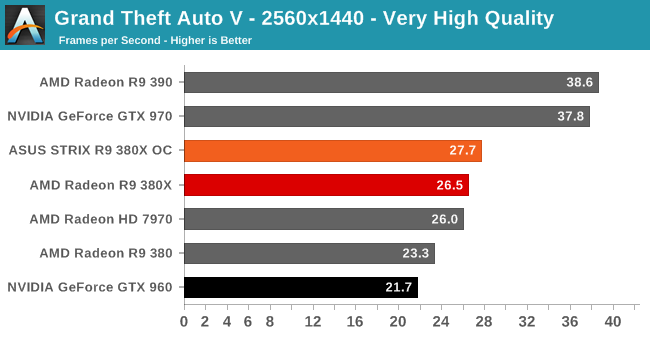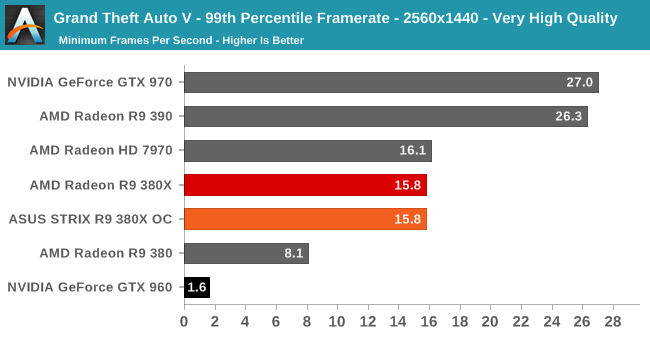The AMD Radeon R9 380X Review, Feat. ASUS STRIX
by Ryan Smith on November 23, 2015 8:30 AM EST- Posted in
- GPUs
- AMD
- Radeon
- Asus
- Radeon 300
Grand Theft Auto V
The open world action game in our benchmark suite is also the last game in our suite: Grand Theft Auto V. The latest edition of Rockstar’s venerable series of open world games, Grand Theft Auto V was originally released to the last-gen consoles back in 2013. However thanks to a rather significant facelift for the current-gen consoles and PCs, along with the ability to greatly turn up rendering distances and add other features like MSAA and more realistic shadows, the end result is a game that is still among the most stressful of our benchmarks when all of its features are turned up.
On a quick note about settings, as Grand Theft Auto V doesn't have pre-defined settings tiers, I want to quickly note what settings we're using. For "Very High" quality we have all of the primary graphics settings turned up to their highest setting, with the exception of grass, which is at its own very high setting. Meanwhile 4x MSAA is enabled for direct views and reflections. This setting also involves turning on some of the advanced redering features - the game's long shadows, high resolution shadows, and high definition flight streaming - but not increasing the view distance any further.


Grand Theft Auto V is another game that punishes 2GB cards to a degree, which plays into the R9 380X’s favor. At 1080p this helps to keep the card 11% ahead of the GTX 960 and 5% ahead of the R9 380. That said, GTA is the one game where perhaps even the R9 380X isn’t powerful enough for no-compromises 1080p gaming, and while 38fps is more than playable (this was a 30fps console game), the 60fps PC standard will require giving up MSAA to hit that mark.


Meanwhile the 99th percentile framerates further drive home the point about 2GB cards being insufficient. However it also points out how even the R9 380X can’t stay above 30fps at all times, reiterating what we said above about possibly needing to drop MSAA to get the best 1080p performance on the R9 380X.










101 Comments
View All Comments
Samus - Monday, November 23, 2015 - link
I had the Asus GTX970 Turbo and it had the grindiest ball bearing fan I've ever heard. It brought me back to the Athlon's YS Tech and Delta days. The "Titan" cooler on my old GTX770 was virtually silent in comparison.So Asus has their duds, but the Strix seems to be a great cooler if you don't need a blower...but many of us do. In a bit a shame toward Asus, I replaced their Turbo with a PNY 970 (also a blower) and the PNY feels cheaper, but cools better and makes less noise.
evilspoons - Tuesday, November 24, 2015 - link
Don't get me wrong here, I really like ASUS stuff - but they have let me down several times on cheapo video card cooling systems. Nasty sleeve bearing fans on half-height Radeon 6580s that vibrate then seize, which was really cheeky considering the box had a "high quality fan omg!!" thing as part of its marketing material.Ended up replacing the half-height card with a passively cooled one - and a nearby 80 mm case fan - so I couldn't have a crappy onboard fan, since every other card on the market seemed to be carrying the same stupid POS fan. I couldn't even spend more to get a better one!
Margalus - Monday, November 23, 2015 - link
I wouldn't get anything other than a EVGA cooling system.. I have the ACX 2.0 verions of a 970 and a 980 ti, and they are really fantastic... lolSamus - Tuesday, November 24, 2015 - link
EVGA is great, but they don't make Radeon cards. It's important to point out, as well, that EVGA is actually NOT NVidia's OEM partner. PNY is. PNY makes a ton of cards based off NVidia's reference designs, which I think are the best. The Titan cooler used on reference 770/780/970/980 GPU's, specifically the vapor-chamber variant, is unsurpassed by any other partners'. That's why almost every partner makes at least one variant of these GPU's with the Titan cooler. They don't make many, because the rumor is NVidia charges $30 for the vapor chamber cooler and it is more expensive to manufacture the cards because of the installation (GPU binding) technique.But EVGA has probably the best, easiest to deal with warranty. Unfortunately I've had to use it.
tamalero - Tuesday, November 24, 2015 - link
If use Sapphire's DualX and triX for the AMD camp imho.I'm still with my trusty 7950 dual X OC. and works wonders!
just4U - Friday, November 27, 2015 - link
From what I understand Sapphire started with the vapor chamber type cards on a few of their Radeons 6 years ago.. Interesting that Nvidia went that route. I'd never heard of any other company doing it before and didn't know they had that on their high end coolers..maecenas - Monday, November 23, 2015 - link
Fair enough, I am generalizing based on an observation pool of 2, which I shouldn't do, but I really enjoy having a silent GPU that doesn't go over 65C! It seems that cooling technology has progressed across the board, which is great news for everyone.BurntMyBacon - Tuesday, November 24, 2015 - link
@maecenasI agree they have a nice cooling system. They may even have the best at the moment. That said, I do believe they have some good competition in this area. MSI impressed me with their Twin Frozer design back before Asus had a DirectCU design out. They've been constantly improving since then. Saphire (much as I dislike them) released some very appealing vapor chamber designs. EVGA had pretty decent blower coolers, but nothing really standout until their second revision of their non-blower design (ACX 2.0). The ACX 2.0+ is copper heaven. I don't really favor designs that just throw another fan at it without really giving much thought to the heatsink design like Gigabyte's Windforce cards. I feel like MSI set the bar with their original Twin Frozer cards and since then, MSI, Asus, Saphire (sigh), and now EVGA have been vying for dominance in the cooling department.
just4U - Friday, November 27, 2015 - link
Strix is nice but MSI's cooling solution is just as good.olivaw - Monday, November 23, 2015 - link
Did I miss the GTX 960 review???